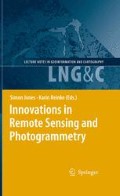Abstract
The objective of this study was to investigate the potential for mapping fallow land management practices on local farm scale in Southern Queensland, Australia, using high temporal frequency satellite remote sensing over a period of six years. The Moderate Resolution Imaging Spectroradiometer (MODIS) was chosen as it provides a temporal resolution fine enough to detect ground cover change within cropping cycles (fallow periods). Previous studies have successfully employed MODIS data detecting cropping patterns in Kansas, North America and Northern Kazakhstan.
Multivariate logistic regression examined the relationship between fallow management practices and image data. A binary response was formed by classifying observations during fallow periods as either cultivated (ploughed) or non-cultivated (zero-tillage).
Explanatory data represented 8-day 500 m as well as 16-day 250 m MODIS composite imagery, and derived vegetation indices (Normalized Difference Vegetation Index, Enhanced Vegetation Index, Normalized Cellulose Absorption Index and Normalized Difference Tillage Index). The combination of bands and indices characterized a broad explanatory source and showed high predictive ability (area under the receiver operating curve: 0.788) distinguishing between cultivated and non-cultivated fallow periods.
The ability to discriminate sprayed and non-sprayed areas using immediate pre and post event imagery during fallow times was also investigated. Reasonable predictive power (0.724 area under the receiver operating curve) was achieved based on the MODIS 8-day 500 m composite data.
The results were promising and suggest that there is considerable potential for differentiating land management practices during fallows periods. This information is valuable for modelling erosion risk, understanding potential on-farm impacts on productivity and off-farm impacts on water quality.
Access this chapter
Tax calculation will be finalised at checkout
Purchases are for personal use only
References
Crawley, M. J. (2002). Statistical Computing, An Introduction to Data Analysis using S-Plus. West Sussex, John Wiley and Sons.
Daughtry, C. S. T., E. R. Hunt Jr., D. P.C. and J. E. McMurtrey III (2005). “Remote Sensing the Spatial Distribution of Crop Residues.” Agronomy Journal 97: 864–871.
Jensen, J. R. (2005). Introductory Digital Image Processing, A Remote Sensing Perspective. Upper Saddle River, USA, Prentice Hall.
Kleinbaum, D. G. (1994). Logistic Regression. New York, Springer Verlag.
Muratova, N. and A. Terekhov (2004). “Estimation of Spring Crops Sowing Calendar Dates using MODIS in Northern Kazakhstan.” IEEE 2/04(c): 4019–4020.
NRM (2005). Development of Methodology to Map Land Use Change and Application to the Fitzroy River Catchment. Brisbane, Queensland Land Use Mapping Program, Land & Environment Assessment, Department of Natural Resources & Mines.
Python (2001). Python Language. http://www.python.org.
R (2006). R 2.3, A Language and Environment for statistical computing. R. D. C. Team. Vienna, R Foundation for Statistical Computing. http://www.R-project.org.
Sultangazin, U., N. Muratova, P. Doraiswamy and A. Terekhov (2004). “Monitoring of crop rotation and weed infestation estimation using MODIS 2004.” IEEE 6: 4036–4069.
van Schalkwyk, L. and J. van Schalkwyk (2001). The worldwide anaesthetist. The magnificent Receiver Operating Characteristic curve. http://www.anaesthetist.com/mnm/stats/roc, accessed on 14th April 2006.
Wardlow, B. D. and S. L. Egbert (2002). Discriminating cropping patterns in the U.S. Central Great Plains region using time-series MODIS 250-meter NDVI data - Preliminary Results. Pecora 15 and Land Satellite Information IV Conference.
Author information
Authors and Affiliations
Corresponding author
Editor information
Editors and Affiliations
Rights and permissions
Copyright information
© 2009 Springer-Verlag Berlin Heidelberg
About this chapter
Cite this chapter
Schroers, RD., Denham, R., Witte, C. (2009). Investigating the Potential for Mapping Fallow Management Practises Using MODIS Image Data. In: Jones, S., Reinke, K. (eds) Innovations in Remote Sensing and Photogrammetry. Lecture Notes in Geoinformation and Cartography. Springer, Berlin, Heidelberg. https://doi.org/10.1007/978-3-540-93962-7_26
Download citation
DOI: https://doi.org/10.1007/978-3-540-93962-7_26
Published:
Publisher Name: Springer, Berlin, Heidelberg
Print ISBN: 978-3-540-88265-7
Online ISBN: 978-3-540-93962-7
eBook Packages: Earth and Environmental ScienceEarth and Environmental Science (R0)

